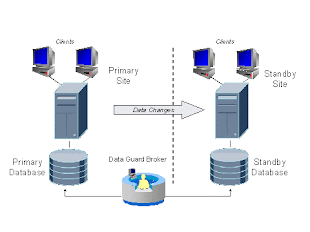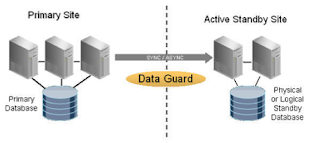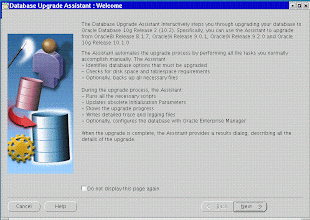
Wednesday, December 10, 2008
Oracle 11gR2 Installation on RHEL 4
Oracle released 11g Release 2 and I was just waiting to get my fingers on it…!!! So downloaded the software from OTN and installed it on Linux. As of now, the software is available only on Linux.[...]
Continue Reading...

Wednesday, December 10, 2008
Dataguard Adventures - Part I...!!!!!
So, I started working on Phase-I of DR implementation....!!!! [...]
Continue Reading...

Wednesday, December 10, 2008
Dataguard Adventures - Part II...!!!!!…
In my last post,we eneded up with primary shipping archivelogs to standby that are being applied to standby.The next steps would be to setup DG BROKER for this setup to automate switchover and failover.[...]
Continue Reading...

Wednesday, December 10, 2008
When ASM rebalancing stops...!!!!
Was adding disks to ASM diskgroups few days back as a part of weekly space addition. Added one disk to each of the ASM diskgorup (CDBP and CDBP2). The disk space got reflected in both the diskgroups, but lot of interesting things were waiting for me. I was able to use space the space in CDBP2 diskgroup for tablespaces but CDBP diskgroup space got jammed…., [...]
Continue Reading...

Monday, December 8, 2008
Reducing Downtime during database movement and migrations
There are lot of strategies possible for moving a database from one server to another. The things are to be planned in a much better way when we have to do multiple things in a single window. This is what I did some time back for a database and server migration with a minimum downtime and pretty good backout plan. [...]
Continue Reading...
Database Cloud Service or (Database as a Service) on OPC (Oracle Public Cloud)
I recently starting working on Oracle Public Cloud, so my next posts will be focussed on different services available on OPC and use cases for them.
Oracle is offering PAAS and IAAS services.Here's a quick link to services that oracle has to offer along with their pricing.
Being a database guy, my interest will be to test the database services. Oracle offers these 2 services on database front
1) DBCS - Database Cloud Service or Database as a Service
DBCS provides an option to create standalone as well as RAC database on cloud. As part of provisioning this service, software is installed for you and database is created. As of now, a service can be created with 11.2.0.4 and 12.1.0.2 database versions. With DBCS, oracle provides cloud tooling - tools to take backup/recovery and patching databases.Backups are automatically scheduled when the service is created and PSU patches can be applied with the click of a button from DBCS console.
The interesting part of DBCS is RAC which is not available on any other public cloud. As of now, you can build a 2 node rac cluster with 12c clusterware and 11g/12c database. With multi tenancy available from 12c, container database is the option available for creating 12c databases,
Another interesting point about DBCS is databases are encrypted by default. Being on cloud, customers are always concerned about the security of their data. So customer database is encryoted by default on cloud. DBCS uses TDE for data encryption at rest and TDE works the same way it is implemented for on-prem databases. Network encryption and integrity (12c feature) is enforced for in-flight data.
Scaling is another good feature in DBCS. For increased load, you can actually scale up a machine to to a different shape of higher memory/cpu. This of course can be done with the click of a button.
2) Virtual Image
Virtual image is a service where VM is created and software is staged for you on the VM. You can add additional block storage using cloud console and install the software and create database. Cloud tooling is not available as part of this service which means customer has to schedule backups and patch databases manually like they do for on-prem databases.
A good thing about both services is that you will get complete shell access (root as well as oracle OS user) and do your stuff.
These services are available on 4 database editions
1) Standard Edition
2) Enterprise Edition
3) High Perfromance
4) Extreme Performance
High and Extreme Performance are not the new editions but just just differentiation on the basis of options they provide. Here's quick link on the features available in these database service editions.
Dataguard is available in Enterprise, High and Extreme performance editions while RAC is available only in Extreme Performance Edition.
For creating the database deployments, there are 2 compute options
1) General Purpose Compute
General purpose compute provides these 5 options. OCPU is Oracle Compute Unit.
OC3 - 1 OCPU, 7.5 GB RAM
OC4 - 2 OCPU, 15 GB RAM
OC5 - 4 OCPU, 30 GB RAM
OC6 - 8 OCPU, 60 GB RAM
OC7 - 16 OCPU, 120 GB RAM
2) High Memory Compute
High memory compute is suitable for high memory requirements
OC3 - 1 OCPU, 7.5 GB RAM
OC4 - 2 OCPU, 15 GB RAM
OC5 - 4 OCPU, 30 GB RAM
OC6 - 8 OCPU, 60 GB RAM
OC7 - 16 OCPU, 120 GB RAM
ExaCS-Exadata Cloud Service
Apart from DBCS and RAC, Exadata is also available on cloud. This is really a superb and affordable option for customers who still don't have on-prem Exadata and want to play with it or customers who want do quick POCs for their applications. ExaCS is available as Quarter, Half and Full Rack with additional OCPU options. This means you can get available racks and scale up the service with additional OCPUs.
I'll explore a lot of these interesting features in coming days and blog them. So stay tuned...!!!
Subscribe to:
Post Comments (Atom)
No comments:
Post a Comment